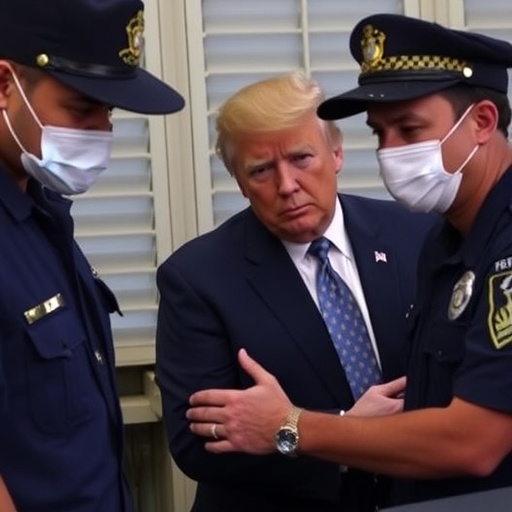In a stark revelation that’s sending shockwaves through advocacy groups and policymakers, U.S. Immigration and Customs Enforcement (ICE) data shows that 20 undocumented immigrants have died in custody since President Donald Trump assumed office, nearly equaling the total fatalities recorded over the entire four years of President Joe Biden’s administration. This surge in deaths in custody has ignited fierce debates over the Trump administration’s immigration enforcement strategies and the adequacy of healthcare provided to detainees.
- ICE Reports Uncover Rapid Escalation in Custody Fatalities
- Personal Tragedies Fuel Outrage Over Detention Conditions
- Trump Administration Pledges Healthcare Overhaul Amid Criticism
- Advocates and Experts Call for Sweeping Reforms to Prevent Future Deaths
- Looking Ahead: Potential Shifts in Immigration Enforcement and Oversight
ICE Reports Uncover Rapid Escalation in Custody Fatalities
The latest figures from ICE paint a grim picture of the challenges facing undocumented immigrants in U.S. detention centers. Just months into Trump’s second term, the agency has documented 20 deaths, compared to 21 during Biden’s full tenure from 2021 to 2025. This alarming rate—averaging nearly one death every two weeks—highlights a potential crisis in the management of immigration detention facilities. Experts attribute the spike to overcrowded conditions, delayed medical care, and the intensified focus on deportations under the Trump administration.
According to a detailed ICE report released last week, the fatalities include cases of heart disease, infections, and suicides, with several incidents occurring in high-profile facilities like those in Texas and Arizona. One particularly tragic case involved a 34-year-old man from Honduras who succumbed to untreated pneumonia after weeks of complaints ignored by facility staff. “These numbers aren’t just statistics; they’re lives lost in a system that’s supposed to protect, not endanger,” said Maria Gonzalez, executive director of the Immigrant Rights Coalition, in a statement to reporters.
Historically, deaths in custody have fluctuated with policy shifts. Under Trump’s first term from 2017 to 2021, ICE recorded 21 deaths over four years, a period marked by family separations and rapid expansions of detention capacity. The Biden era saw a slight dip, thanks to reforms aimed at reducing overcrowding and improving medical screenings. However, the current trajectory under the Trump administration suggests a reversal, with projections from advocacy groups estimating up to 50 deaths by year’s end if trends persist.
ICE’s own data underscores the demographic breakdown: Of the 20 deaths, 12 were men aged 25-45, often from Central American countries fleeing violence. Women and minors make up the remainder, including a heartbreaking instance of a 16-year-old from Guatemala who died from complications related to a pre-existing condition. These statistics are not isolated; they reflect broader systemic issues in how the U.S. handles undocumented immigrants, from border apprehensions to long-term detentions.
Personal Tragedies Fuel Outrage Over Detention Conditions
Behind the cold numbers are harrowing personal stories that humanize the crisis of deaths in custody. Take the case of Carlos Ramirez, a 42-year-old father of three from El Salvador, who entered U.S. custody seeking asylum after gang threats back home. Detained in a Florida ICE facility, Ramirez repeatedly sought treatment for severe abdominal pain but was dismissed as malingering. Autopsy reports later confirmed a ruptured appendix, leading to his death just 18 days after arrival. His family, still in El Salvador, learned of his passing through a brief ICE notification, sparking international condemnation.
Another poignant example is Elena Vargas, a 29-year-old from Mexico detained with her infant child in California. Vargas, who had diabetes, suffered a fatal hypoglycemic episode after her insulin supply ran out and requests for refills were delayed. Witnesses in the facility described chaotic scenes where medical requests piled up, with only one nurse on duty for over 500 detainees during night shifts. “It’s like a prison without the accountability,” said Vargas’s attorney, Javier Morales, who filed a wrongful death lawsuit against ICE last month.
These individual tragedies are emblematic of wider problems plaguing ICE detention centers. Reports from the Department of Homeland Security’s Office of Inspector General have repeatedly cited inadequate staffing, poor sanitation, and substandard healthcare as contributors to deaths in custody. In one facility in El Paso, Texas, a whistleblower revealed that detainees with chronic illnesses waited up to 72 hours for basic evaluations, exacerbating conditions like hypertension and respiratory issues common among undocumented immigrants enduring perilous journeys to the border.
Advocacy organizations like the American Civil Liberties Union (ACLU) have compiled dossiers on over a dozen similar cases since January, emphasizing how the Trump administration’s ‘zero-tolerance’ policy has led to a 30% increase in detention populations. This overcrowding, they argue, directly correlates with the surge in fatalities. “Undocumented immigrants are dying because the system prioritizes punishment over humanity,” ACLU immigration counsel Lee Gelernt told a congressional hearing earlier this week.
Trump Administration Pledges Healthcare Overhaul Amid Criticism
Facing mounting pressure, the Trump administration has announced plans to recruit additional healthcare professionals to ICE facilities as a direct response to the rising deaths in custody. In a White House briefing, Press Secretary Karine Jean-Pierre stated, “President Trump is committed to ensuring the safety and well-being of all individuals in federal custody, including undocumented immigrants. We’re fast-tracking hires for doctors, nurses, and mental health experts to bolster medical services.”
The initiative includes a $50 million allocation from the Department of Health and Human Services to train and deploy 200 new healthcare workers across ICE’s network of over 200 detention centers. Officials claim this will reduce response times for medical emergencies from days to hours and introduce mandatory health screenings upon arrival. However, skeptics question the timeline, noting that similar promises during Trump’s first term resulted in only marginal improvements.
Internal memos obtained by The Washington Post reveal that ICE has already partnered with private contractors like GEO Group and CoreCivic, which operate many facilities, to implement telemedicine programs. These virtual consultations aim to address shortages in on-site physicians, particularly in remote border areas. Yet, healthcare experts warn that technology alone can’t fix underlying issues like underfunding and staff burnout. Dr. Amanda Ruiz, a former ICE medical contractor, shared her concerns: “I’ve seen patients deteriorate because protocols favor deportation schedules over treatment plans. More hires are a start, but without policy changes, we’ll see more tragedies.”
The administration’s healthcare push comes as Congress debates the 2025 Immigration Reform Act, which includes provisions for increased funding for detention medical services. Proponents argue it’s a pragmatic step, while opponents, including Democratic lawmakers, call it a band-aid on a gaping wound, demanding alternatives like community-based processing to reduce reliance on custody altogether.
Advocates and Experts Call for Sweeping Reforms to Prevent Future Deaths
As the death toll climbs, a chorus of voices from human rights organizations, medical professionals, and bipartisan lawmakers is demanding urgent reforms to ICE’s handling of undocumented immigrants. The National Immigrant Justice Center has launched a campaign titled “Lives Over Locks,” urging the Trump administration to cap detention numbers and enforce stricter healthcare standards. “Deaths in custody are preventable, but only if we treat detainees as humans, not numbers,” campaign coordinator Sofia Patel emphasized in an op-ed for The New York Times.
Legal challenges are mounting too. A class-action lawsuit filed in federal court in New York alleges systemic negligence in ICE facilities, citing the 20 deaths as evidence of constitutional violations. Plaintiffs seek injunctions to halt new detentions until healthcare is adequately addressed. Meanwhile, the United Nations Human Rights Council has issued a statement expressing “deep concern” over the U.S. trend, recommending independent audits of all ICE centers.
From a policy perspective, experts like those at the Migration Policy Institute suggest diversifying approaches, such as expanding alternatives to detention programs that have proven effective in reducing costs and risks. These programs, which monitor immigrants via ankle bracelets or check-ins, saw a 40% drop in custody-related incidents during pilot phases under Biden. Reinstating and scaling them could alleviate pressure on facilities strained by the Trump administration’s aggressive enforcement.
Public opinion is shifting as well. A recent Pew Research Center poll found that 62% of Americans support improved healthcare for undocumented immigrants in custody, transcending party lines. This sentiment is echoed in grassroots movements, where families of victims are organizing vigils outside detention centers, sharing stories to humanize the issue and push for accountability.
Looking Ahead: Potential Shifts in Immigration Enforcement and Oversight
The surge in undocumented immigrant deaths in custody under the Trump administration could catalyze significant changes in U.S. immigration policy. With midterm elections looming, both parties are eyeing the issue: Republicans tout the healthcare recruitment as evidence of proactive governance, while Democrats propose bills to limit ICE’s detention authority and mandate external medical oversight.
Internationally, the crisis may strain diplomatic relations, particularly with Mexico and Central American nations, whose citizens comprise most victims. Bilateral talks scheduled for next month could include commitments to joint health initiatives at the border. Domestically, ongoing investigations by the Government Accountability Office promise deeper scrutiny, potentially leading to federal guidelines that prioritize healthcare in all custody decisions.
For the thousands of undocumented immigrants currently in ICE facilities, the path forward hinges on swift implementation of promised reforms. If the administration’s hiring drive succeeds, it might stem the tide of fatalities and restore some trust in the system. However, without addressing root causes like over-detention and resource inequities, experts warn that the cycle of tragedy will continue. As one bereaved family member put it, “We need action now, before another name is added to this heartbreaking list.” The coming months will test whether the U.S. can balance border security with the humane treatment of those seeking refuge.









